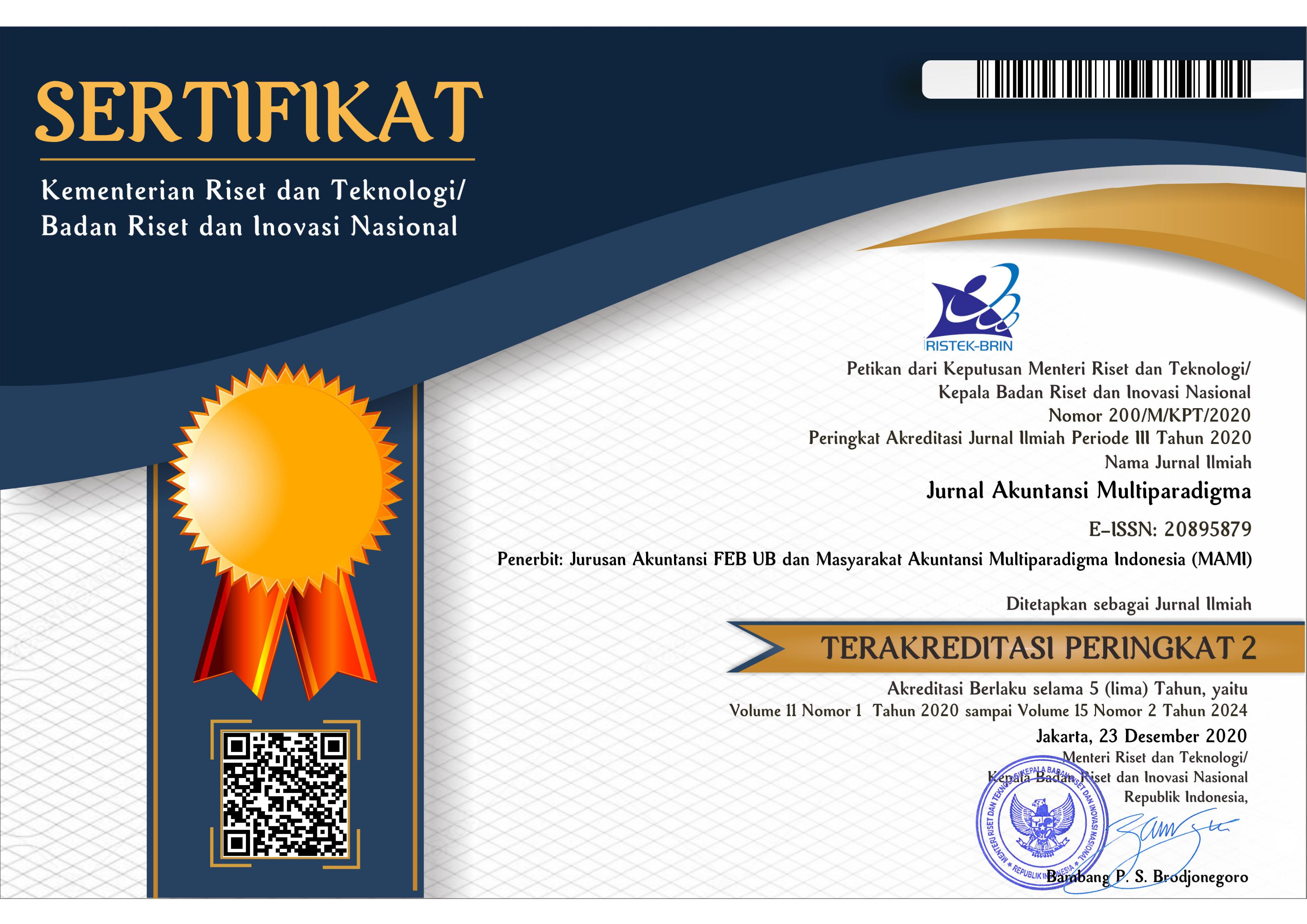PERAN PROFITABILITAS SEBAGAI PENENTU KUALITAS PELAPORAN KEUANGAN
Abstract
Abstrak - Peran Profitabilitas sebagai Penentu Kualitas Pelaporan Keuangan
Tujuan Utama – Penelitian ini berupaya menguji peran mediasi profitabilitas dalam pengaruh faktor penentu terhadap kualitas dari pelaporan keuangan.
Metode - Metode penelitian menggunakan regresi data panel dan analisis jalur. Adapun sampel dalam penelitian ini adalah 28 perusahaan LQ-45 periode 2015-2018.
Temuan Utama - Penelitian ini menemukan profitabilitas mampu memediasi sejumlah variabel faktor penentu kualitas pelaporan keuangan dalam hal rasio keuangan. Hal ini menandakan bahwa profitabilitas menjadi tujuan perusahaan untuk menjaga rasio keuangan sehingga tercipta pelaporan keuangan berkualitas. Meskipun demikian, profitabilitas tidak mampu memediasi umur dan ukuran perusahaan terhadap kualitas pelaporan keuangan karena persoalan pengungkapan informasi.
Implikasi Teori dan Kebijakan - Penelitian menunjukkan kepada setiap pihak untuk berhati dalam mencermati siklus bisnis perusahaan. Selain itu, investor untuk berhati-hati dalam memilih perusahaan.
Kebaruan Penelitian - Penambahan profitabilitas sebagai variabel mediasi merupakan upaya baru dalam pencarian penentu kualitas laporan keuangan.
Abstract - The Role of Profitability to Determine Financial Reporting Quality
Main Purpose - This research examines the mediating role of profitability in the influence of determinants on the quality of financial reporting.
Method - The research uses panel data regression and path analysis as methods. The samples in this study were 28 LQ-45 companies for the 2015-2018 period.
Main Findings - This study finds that profitability can mediate several variable determinants of financial reporting quality in financial ratios. This result indicates that profitability is the company's goal to maintain financial ratios to create quality financial reporting. However, profitability cannot mediate the age and size of the company on the quality of financial reporting due to disclosure issues.
Theory and Practical Implications – This research implies that every party should examine the company's business cycle. In addition, investors must be careful in choosing companies.
Novelty - The addition of profitability as a mediating variable is a new effort to search for determinants of the quality of financial reports.
Keywords
Full Text:
PDFReferences
Affianti, D., & Supriyati (2017), The Effect of Good Corporate Governance, Firm Size, Leverage and Profitability on Accounting Conservatism Level in Banking Industry. The Indonesian Accounting Review, 7(1), 191-202. https://doi.org/10.14414/tiar.v7i2.947
Ammar, S. (2017). Enterprise Systems, Business Process Management and UK-Management Accounting Practices: Cross-sectional Case Studies. Qualitative Research in Accounting & Management, 14(3), 230-281. https://doi.org/10.1108/QRAM-05-2016-0044
Appiah, K. O., Awunyo-Vitor, D., Mireku, K., & Ahiagbah, C. (2016). Compliance with International Financial Reporting Standards: The Case of Listed Firms in Ghana. Journal of Financial Reporting and Accounting, 14(1), 131-156. https://doi.org/10.1108/JFRA-01-2015-0003
Arshad, R., Iqbal, S. M., & Omar, N. (2015). Prediction of Business Failure and Fraudulent Financial Reporting: Evidence from Malaysia. Indian Journal of Corporate Governance, 8(1), 34–53. https://doi.org/10.1177/0974686215574424
Asche, F., Sikveland, M., & Zhang, D. (2018). Profitability in Norwegian Salmon Farming: The Impact of Firm Size and Price Variability. Aquaculture Economics & Management, 22(3), 306-317. https://doi.org/10.1080/13657305.2018.1385659
Banker, R. D., Fang, S., & Mehta, M. N. (2020). Anomalous Operating Performance During Economic Slowdowns. Journal of Management Accounting Research, 32(2), 57–83. https://doi.org/10.2308/jmar-52547
Bentley-Goode, K. A., Newton, N. J., & Thompson, A. M. (2017). Business Strategy, Internal Control over Financial Reporting, and Audit Reporting Quality. AUDITING: A Journal of Practice & Theory 1 November 2017; 36 (4): 49–69. doi: https://doi.org/10.2308/ajpt-51693
Billett, M., & Yu, M. (2016). Asymmetric Information, Financial Reporting, and Open-Market Share Repurchases. Journal of Financial and Quantitative Analysis, 51(4), 1165-1192. https://doi.org/10.1017/S0022109016000612
Blažková, I., & Dvouletý, O. (2018). The Causes of Firm Performance Variation in the Czech food Processing Industry in the Context of the Outlier Effect. Management Research Review, 41(8), 968-986. https://doi.org/10.1108/MRR-05-2017-0142
Bouzgarrou, H., Jouida, S., & Louhichi, W. (2018). Bank Profitability during and Before the Financial Crisis: Domestic versus Foreign Banks. Research in International Business and Finance, 44, 26-39. https://doi.org/10.1016/j.ribaf.2017.05.011
Bowrin, A. R. (2015). Comprehensiveness of Internet Reporting by Caribbean Companies. Journal of Accounting in Emerging Economies, 5(1), 2-34. https://doi.org/10.1108/JAEE-08-2011-0028
Bushee, B. J., Jung, M. J., & Miller, G. S. (2017). Do Investors Benefit from Selective Access to Management? Journal of Financial Reporting, 2(1), 31–61. https://doi.org/10.2308/jfir-51776
Call, A. C., Hewitt, M., Shevlin, T., & Yohn, T. L. (2016). Firm-Specific Estimates of Differential Persistence and their Incremental Usefulness for Forecasting and Valuation. The Accounting Review, 91(3), 811–833. doi: https://doi.org/10.2308/accr-51233
Camino-Mogro, S., & Bermúdez-Barrezueta, N. (2019). Determinants of Profitability of Life and Non-Life Insurance Companies: Evidence from Ecuador. International Journal of Emerging Markets, 14(5), 831-872. https://doi.org/10.1108/IJOEM-07-2018-0371
Chen, K. C., Cheng, Q., Lin, Y. C., Lin, Y., & Xiao, X. (2016). Financial Reporting Quality of Chinese Reverse Merger Firms: The Reverse Merger Effect or the Weak Country Effect? The Accounting Review, 91(5), 1363–1390. https://doi.org/10.2308/accr-51376
Das, R. C., Mishra, C. S., & Rajib, P. (2018). Firm-Specific Parameters and Earnings Management: A Study in the Indian Context. Global Business Review, 19(5), 1240–1260. https://doi.org/10.1177/0972150918788748
Du, Q., Wang, Y., & Wei, K. C. J. (2020). Does Cash-Based Operating Profitability Explain the Accruals Anomaly in China? Pacific-Basin Finance Journal, 61(1), 1-20. https://doi.org/10.1016/j.pacfin.2020.101336
Forst, A., Hettler, B., & Barniv, R. R. (2019). Insider Ownership and Financial Analysts’ Information Environment: Evidence From Dual-Class Firms. Journal of Accounting, Auditing & Finance, 34(1), 30–53. https://doi.org/10.1177/0148558X16670048
Gang, J., Qian, Z., & Xu, T. (2019). Investment Horizons, Cash Flow News, and the Profitability of Momentum and Reversal Strategies in the Chinese Stock Market. Economic Modelling, 83, 364-371. https://doi.org/10.1016/j.econmod.2019.08.021
Giotopoulos, I. (2014). Dynamics of Firm Profitability and Growth: Do Knowledge-Intensive (Business) Services Persistently Outperform? International Journal of the Economics of Business, 21(3), 291-319. https://doi.org/10.1080/13571516.2014.921364
Guragai, B., & Hutchison, P. D. (2020). Financial Performance Following Discontinued Operations. Review of Accounting and Finance, 19(4), 429-447. https://doi.org/10.1108/RAF-10-2019-0224
Haddad, A. E., Shibly, F. B., & Haddad, R. (2020). Voluntary Disclosure of Accounting Ratios and Firm-Specific Characteristics: The Case of GCG. Journal of Financial Reporting and Accounting, 18(2), 301-324. https://doi.org/10.1108/JFRA-04-2019-0055
Hassan, M. K., Abbas, B. A., & Garas, S. N. (2019). Readability, Governance and Performance: A Test of the Obfuscation Hypothesis in Qatari Listed Firms. Corporate Governance, 19(2), 270-298. https://doi.org/10.1108/CG-05-2018-0182
Hasnan, S., Razali, M. H. M., & Hussain, A. R. M. (2020). The Effect of Corporate Governance and Firm-Specific Characteristics on the Incidence of Financial Restatement. Journal of Financial Crime, 28(1), 244-267. https://doi.org/10.1108/JFC-06-2020-0103
Irvine, P. J., Park, S. S., & Yıldızhan, C. (2016). Customer-Base Concentration, Profitability, and the Relationship Life Cycle. The Accounting Review, 91(3), 883–906. https://doi.org/10.2308/accr-51246
Kwak, K., & Kim, W. (2016). Effect of Service Integration Strategy on Industrial Firm Performance/ Journal of Service Management, 27(3), 391-430. https://doi.org/10.1108/JOSM-03-2014-0088
Lim, J., Lee, J., & Chang, J. (2015), Financial Reporting Quality of Target Companies and Acquirer Returns: Evidence from Korea. International Journal of Accounting & Information Management, 23(1), 16-41. https://doi.org/10.1108/IJAIM-07-2014-0052
Lindholm, A., Laine, T. J., & Suomala, P. (2017). The Potential of Management Accounting and Control in Global Operations: Profitability-Driven Service Business Development. Journal of Service Theory and Practice, 27(2), 496-514. https://doi.org/10.1108/JSTP-05-2016-0106
Luypaert, M., Caneghem, T. V., & Uytbergen, S. V. (2016). Financial Statement Filing Lags: An Empirical Analysis among Small Firms. International Small Business Journal, 34(4), 506–531. https://doi.org/10.1177/0266242615569324
Ma, S., & Ma, L. (2017). The Association of Earnings Quality with Corporate Performance: Evidence from the Emerging Market of China. Pacific Accounting Review, 29(3), 397-422. https://doi.org/10.1108/PAR-02-2016-0014
Maradona, A. F. (2020). Aggressive Reporting Behaviour under the Implementation of Indonesian Accounting Standards. Jurnal Akuntansi Multiparadigma, 11(1), 23-38. https://doi.org/10.21776/ub.jamal.2020.11.1.02
Maroun, W. (2015). Culture, Profitability, Non-Financial Reporting and a Meta-Analysis: Comments and Observations. Meditari Accountancy Research, 23(3), 322-330. https://doi.org/10.1108/MEDAR-04-2015-0020
Mokhtar, E. S. (2017). Internet Financial Reporting Determinants: A Meta-Analytic Review. Journal of Financial Reporting and Accounting, 15(1), 116-154. https://doi.org/10.1108/JFRA-07-2016-0061
Nanda, S., & Panda, A. K. (2019). A Quantile Regression Approach to Trail Financial Performance of Manufacturing Firms. Journal of Applied Accounting Research, 20(3), 290-310. https://doi.org/10.1108/JAAR-06-2018-0091
Nuanpradit, S. (2019). Real Earnings Management in Thailand: CEO Duality and Serviced Early Years. Asia-Pacific Journal of Business Administration, 11(1), 88-108. https://doi.org/10.1108/APJBA-08-2018-0133
O'Connor, E., Hynes, S., Vega, A., & Evers, N. (2019), Examining Performance Change and Its Drivers in Irish Ports 2000-2016. Maritime Business Review, 4(4), 340-364. https://doi.org/10.1108/MABR-04-2019-0015
Pervan, M., Pervan, I., & Ćurak, M. (2019). Determinants of Firm Profitability in the Croatian Manufacturing Industry: Evidence from Dynamic Panel Analysis. Economic Research, 32(1), 968-981. https://doi.org/10.1080/1331677X.2019.1583587
Rangkuti, H. A., Yuliantoro, H. R., & Yefni. (2019). Lebih Penting Mana Sustainability Report atau Laba Bagi Perusahaan Perkebunan? Jurnal Akuntansi Multiparadigma, 10(2), 365-378. https://doi.org/10.18202/jamal.2019.08.10021
Sumani, Roziq, A., & Manurung, D. T. H. (2020). Relevankah Teori Struktur Modal di Indonesia?. Jurnal Akuntansi Multiparadigma, 11(2), 373-385. https://doi.org/10.21776/ub.jamal.2020.11.2.22
Talonpoika, A. M., Monto, S., Pirttilä, M., & Kärri, T. (2014). Modifying the Cash Conversion Cycle: Revealing Concealed Advance Payments. International Journal of Productivity and Performance Management, 63(3), 341-353. https://doi.org/10.1108/IJPPM-12-2012-0130
Tang, Q., Chen, H., & Lin, Z. (2016). How to Measure Country-Level Financial Reporting Quality? Journal of Financial Reporting and Accounting, 14(2), 230-265. https://doi.org/10.1108/JFRA-09-2014-0073
Vitolla, F., Raimo, N., Rubino, M., & Garzoni, A. (2020). The Determinants of Integrated Reporting Quality in Financial Institutions. Corporate Governance, 20(3), 429-444. https://doi.org/10.1108/CG-07-2019-0202
Vorst, P., & Yohn, T. L. (2018). Life Cycle Models and Forecasting Growth and Profitability. The Accounting Review, 93(6), 357–381. https://doi.org/10.2308/accr-52091
Wiengarten, F., Li, H., Singh, P. J., & Fynes, B. (2019). Re-evaluating Supply Chain Integration and Firm Performance: Linking Operations Strategy to Supply Chain Strategy. Supply Chain Management, 24(4), 540-559. https://doi.org/10.1108/SCM-05-2018-0189
Yazdanfar, D., & Öhman, P. (2014). The Impact of Cash Conversion Cycle on Firm Profitability: An Empirical Study Based on Swedish Data. International Journal of Managerial Finance, 10(4), 442-452. https://doi.org/10.1108/IJMF-12-2013-0137
Zeller, T., Kostolansky, J., & Bozoudis, M. (2019). An IFRS-Based Taxonomy of Financial Ratios. Accounting Research Journal, 32(1), 20-35. https://doi.org/10.1108/ARJ-10-2017-0167
DOI: http://dx.doi.org/10.21776/ub.jamal.2021.12.1.13
Refbacks
- There are currently no refbacks.
Copyright (c) 2021 Rida Ristiyana, Erwindiawan

This work is licensed under a Creative Commons Attribution-NonCommercial 4.0 International License.

















